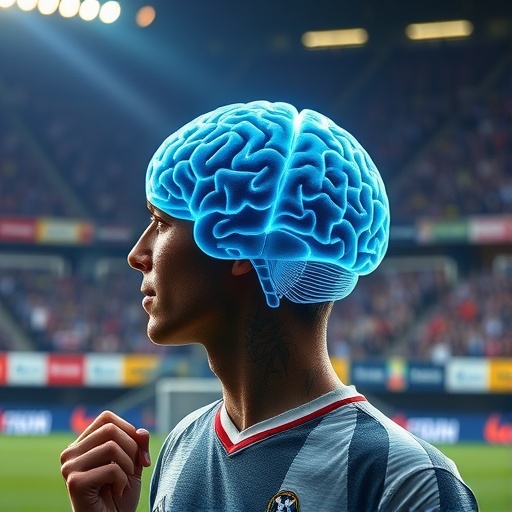In a groundbreaking study published in the prestigious journal Radiology, researchers from Chile have unveiled intricate neurobiological underpinnings of fanaticism by probing the brains of soccer fans during emotionally charged moments. The investigation utilized functional magnetic resonance imaging (fMRI) to elucidate how deeply entrenched emotional and social identifications with sports teams manifest as measurable neural circuit activity, with implications stretching far beyond the stadiums into realms of political and sectarian fanaticism.
Soccer, a sport with an unparalleled global following, presents a rich experimental model for examining social identity in competitive contexts due to its widespread emotional engagement and historical rivalries. Fans’ passionate loyalty can translate into behaviors ranging from jubilant celebration to intense hostility, all underpinned by brain processes that orchestrate their reactions. This study capitalizes on this phenomenon to reveal the neural dynamics of group affiliation and rivalry.
The investigators recruited 60 healthy male participants aged 20 to 45, all ardent fans of two historically rival soccer teams. Fanaticism levels were quantified through the Football Supporters Fanaticism Scale, which evaluates dimensions such as aggression inclination and sense of belongingness, thus capturing psychological dispositions critical to understanding social identity reinforcement mechanisms during sporting events.
Using fMRI technology, the researchers recorded participants’ brain activity as they viewed 63 video sequences of goals scored by their favorite team, the archrival, or a neutral third team. This design allowed the team to parse neural responses associated with significant victories, devastating defeats, and emotionally neutral scenarios, revealing how nuanced brain networks activate during in-group reward experiences versus out-group threat perceptions.
The neuroimaging data unveiled a striking duality: when participants witnessed their favored team score against a rival, reward-related circuits in the brain intensified their activation well beyond what was observed for non-rival wins. This amplification reflects robust in-group bonding and an enhancement of social identity, mediated by regions critical to processing reward and positive reinforcement in the human brain.
Conversely, when the rival team scored against the fans’ own, a paradoxical neural suppression was observed, notably in the dorsal anterior cingulate cortex (dACC). This brain region is integral to cognitive control processes and conflict monitoring, yet under these defeat conditions, its reduced activity suggests a breakdown in regulatory mechanisms. This counterintuitive effect—paradoxical suppression—occurs when individuals attempt to suppress unwanted thoughts or emotions but inadvertently amplify them, underlying emotional dysregulation amid rivalry.
Intriguingly, the degree of reward circuit activation and dACC suppression correlated with measures of fanaticism, with the most fervent supporters exhibiting pronounced neural responses. This suggests a neural signature of vulnerability: when social identity is gravely challenged, usual cognitive control falters, increasing the propensity for impulsive, unregulated reactions. This mechanistic insight sheds light on why even rational individuals can experience sudden emotional outbursts during high-stakes matches.
Lead author Dr. Francisco Zamorano emphasizes the broader societal relevance of these findings. The neural pattern of heightened reward system engagement coupled with diminished cognitive control during rivalry likely transcends sports, resonating in political, sectarian, and ideological conflicts. Recognizing this neural basis opens new avenues for developing mitigation strategies to manage crowd behavior and prevent violence during intense social events.
This study also highlights a critical developmental dimension: the valuation-control brain balance that governs susceptibility to fanaticism is sculpted early in life through caregiving quality, stress exposure, and social learning. As such, early childhood protection and nurturing environments emerge as powerful preventive factors against the cultivation of extreme in-group biases and the resultant social harms.
By harnessing soccer fandom as a real-world, high ecological validity model, researchers can test interventions—from fairness cues and event framing to crowd management techniques—that may fruitfully translate into strategies for mitigating polarization and conflict in society at large. Targeted approaches informed by this neurobiological understanding hold promise for fostering social cohesion and reducing fanatic-driven discord.
Dr. Zamorano draws attention to the urgency of such efforts given contemporary global challenges. He references the January 6, 2021, U.S. Capitol insurrection as a stark illustration of political fanaticism overwhelming democratic norms, mirroring the compromised dACC-based cognitive control observed in this study’s cohort, underscoring the clinical and societal stakes of understanding fanaticism’s neural roots.
Ultimately, this research transcends mere description, offering a scientifically grounded pathway for intervention and prevention strategies aimed at safeguarding public health and democratic resilience. By decoding how extremist identification reconfigures brain circuits of reward and control, it paves the way for interventions that can interrupt the vicious cycles of fanaticism threatening social fabric worldwide.
The study, titled “Brain Mechanisms across the Spectrum of Engagement in Football Fans: A Functional Neuroimaging Study,” features contributions from a multidisciplinary team of neuroscientists and clinicians, encompassing biological, psychological, and medical expertise. Its interdisciplinary insights herald an important advance in the science of social identity, emotional regulation, and group behavior.
Soccer, with its global cultural footprint and passionate adherents, has revealed itself not merely as a sport but as a window into the neural architecture of human sociality, identity, and conflict, promising both scientific and practical dividends in understanding and managing the complexities of human fanaticism.
Subject of Research: People
Article Title: Brain Mechanisms across the Spectrum of Engagement in Football Fans: A Functional Neuroimaging Study
News Publication Date: 11-Nov-2025
Web References:
- Radiology Journal: https://pubs.rsna.org/journal/radiology
- Radiological Society of North America: https://www.rsna.org/
- Patient Information on Brain MRI: http://www.radiologyinfo.org
References:
Zamorano, F., Hurtado, J. M., Carvajal-Paredes, P., Salinas, C., Stecher, X., Soto-Icaza, P., Von Bernhardi, R., Méndez, W., Billeke, P., López, V., Silva, C. (2025). Brain Mechanisms across the Spectrum of Engagement in Football Fans: A Functional Neuroimaging Study. Radiology.
Image Credits: Radiological Society of North America (RSNA)
Keywords: Neuroimaging, Aggression, Group behavior, Social interaction, Emotions




